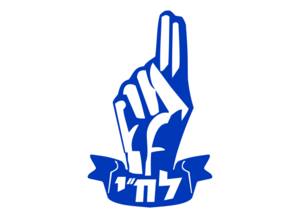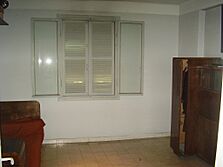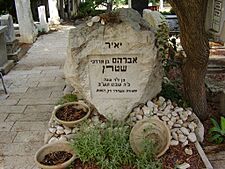Avraham Stern facts for kids
Quick facts for kids
Avraham Stern
|
|
|---|---|

Stern in 1942
|
|
| Native name |
אברהם שטרן
|
| Nickname(s) | Yair |
| Born | December 23, 1907 Suwałki, Russian Empire (present-day Poland) |
| Died | February 12, 1942 (aged 34) Tel Aviv, Mandatory Palestine |
| Cause of death | Execution |
| Buried |
Nahalat Yitzhak Cemetery, Givatayim, Israel
(32.072°N 34.804°E) |
| Allegiance | |
Avraham Stern (Hebrew: אברהם שטרן, Avraham Shtern; December 23, 1907 – February 12, 1942), also known as Yair (Hebrew: יאיר), was an important leader in Jewish groups that aimed for independence in Mandatory Palestine. He was first part of a group called Irgun. In 1940, he started his own group, Lehi, which the British authorities called the "Stern Gang." This group fought against British rule.
Stern's actions are still debated today. His organization tried to get help from Germany against the British during World War II. He was caught and killed by British police in 1942.
Contents
Growing Up and Early Actions
Stern was born in Suwałki, which is now part of Poland. Back then, it was part of the Russian Empire. During the First World War, his mother took him and his brother to safety in Russia. Avraham, at 13, even earned money by carrying water in Siberia. He later moved to St. Petersburg before walking back to Poland. In 1925, when he was 18, Stern moved by himself to Mandatory Palestine.
Studying and Joining the Fight
Stern studied at the Hebrew University in Jerusalem. He focused on old languages like Greek and Latin. He helped start a student group called "Hulda." This group wanted to help create a new Jewish state.
In 1929, there were riots in Palestine. Jewish communities were attacked. Stern joined the Haganah, a Jewish defense group. He helped guard a synagogue in Jerusalem's Old City.
Later, Stern joined the Irgun. This group wanted to be an independent army. They wanted to take more active steps to defend Jewish communities. Stern became an officer in the Irgun in 1932.
Poetry and Patriotism
Avraham Stern wrote many poems. These poems showed his deep love for the Jewish homeland. They also spoke about being willing to die for it. His poems were influenced by Russian and Polish writers.
One of his famous songs was Unknown Soldiers. It became an anthem for the Irgun and later for Lehi. The song was about Jews who would fight for their own country. They would not join other armies while their own land was not free. They would fight secretly and be buried at night. Some people believe this song helped inspire the underground movement.
Travels and Plans
Stern was a top student at the university. He even got a scholarship to study in Florence, Italy. But his commander, Avraham Tehomi, asked him to come back. He wanted Stern to be his second-in-command in the Irgun.
For the rest of the 1930s, Stern traveled to Eastern Europe. He helped organize revolutionary groups in Poland. He also encouraged Jews to move to Palestine, even though the British had rules against it. This was called "illegal immigration."
Stern had a big plan. He wanted to train 40,000 young Jews. They would sail to Palestine and take control from the British. He even got the Polish government to help. They started training Irgun members and set aside weapons. But then Germany invaded Poland, starting World War II. This stopped the training and cut off immigration routes. Stern was in Palestine when the war began. He was arrested and put in prison with other Irgun leaders.
Lehi: A New Path
While in prison, Stern and other Irgun members debated what to do during the war. After he was released in August 1940, Stern started a new group. It was first called something else, but in September 1940, it became Lehi. This name is short for "Fighters for the Freedom of Israel." Lehi was formed because Stern and others disagreed with the Irgun. The Irgun decided to support the British against the Nazis.
Stern believed that fighting the British was the only way to get an independent Jewish state. He thought it was also the only way to help Jews living outside of Palestine. The British had a rule called the White Paper of 1939. It only allowed a small number of Jews to move to Palestine. Stern saw British rule as "foreign rule," no matter what their policies were. He strongly opposed any foreign control.
Stern's ideas were not popular with the main Jewish leaders. But his movement attracted many different kinds of people. Some became very famous later on. These included Yitzhak Shamir, who became an Israeli prime minister. Others like Natan Yellin-Mor later became peace activists.
Stern started organizing his new group in four main ways:
- Publishing a newspaper and making secret radio broadcasts. These explained why they were fighting.
- Getting money for the group. This was done through donations or by robbing British banks.
- Talking with other countries to help save Jews in Europe. They also wanted allies against the British in Palestine.
- Carrying out military-style actions against the British.
These plans were difficult for the new group. They had little money, so their newspapers were hard to make and read. Their bank robberies and attacks on British police led to street fights. Both British and Jewish police were killed or hurt. Stern also tried to talk with the Italians, but this made Lehi's reputation worse.
In January 1941, Stern tried to make a deal with German authorities. He offered to "actively take part in the war on Germany's side." In return, he wanted German support for Jewish immigration to Palestine and a Jewish state. Another attempt to contact the Germans was made later in 1941. No German response was found. These attempts to work with Germany were very different from what other Zionist leaders wanted. They wanted Britain to defeat the Nazis, even if they also wanted the British out of Palestine.
His Final Days
"Wanted" posters with a reward for Stern's capture appeared everywhere. Stern moved from one safe house to another in Tel Aviv. He even carried a folding bed in a suitcase. When he ran out of places to hide, he sometimes slept in apartment stairwells. Eventually, he moved into an apartment rented by Lehi members Moshe and Tova Svorai.
Moshe Svorai was caught by British detectives. This happened after a raid where two Lehi members were killed. Moshe and another man were hurt and sent to the hospital. Stern's contact, Hisia Shapiro, thought she was being followed. She stopped bringing messages to Stern.
On February 12, 1942, she came with one last message. It was from the Haganah. They offered to hide Stern for the rest of the war if he stopped fighting the British. Stern wrote a letter back, saying no to the offer. He suggested that Lehi and the Haganah work together to fight the British.
A few hours later, British detectives arrived to search the apartment. They found Stern hiding inside. The mother of one of the Lehi members had accidentally led the police there. Two neighbors were brought in to witness the search. After they left, Tova Svorai was also taken away. This left Stern alone with three armed British policemen. Then, in circumstances that are still debated today, Stern was shot and killed.
The police report said that Stern was "just finishing lacing his shoes when he suddenly leapt for the window." It said he was "halfway out of the window when he was shot by two of the three policemen." The senior policeman there, Geoffrey J. Morton, later wrote that he feared Stern was about to use an explosive device. Stern had threatened to do this if he was caught.
However, Stern's followers and others disagreed with the police version. They believed that Stern was shot in cold blood, meaning he was killed without a good reason.
His Family's Legacy
Stern's son, Yair, was born a few months after his father's death. He became a broadcast journalist and TV news anchor. He even led Israel Television. Stern's grandson, Shay, is also a media personality and presenter in Israel.
Honors and Memorials
Every year, a memorial ceremony is held at Stern's grave. It is in the Nahalat Yitzhak Cemetery in Givatayim. In 1978, a postage stamp was made in his honor.
In 1981, a town called Kochav Yair was founded. Its name means "Yair's Star," named after Stern's nickname.
The place where he was shot is now a museum. It is visited by many young people who support his ideas.
In January 2016, an actor named Steven Schub played Avraham 'Yair' Stern in a play. The play was called The Ghosts of Mizrachi Bet Street. It was based on Avraham Stern's life.




